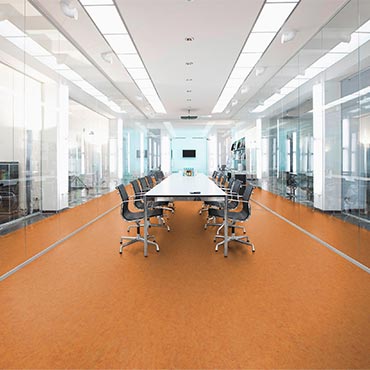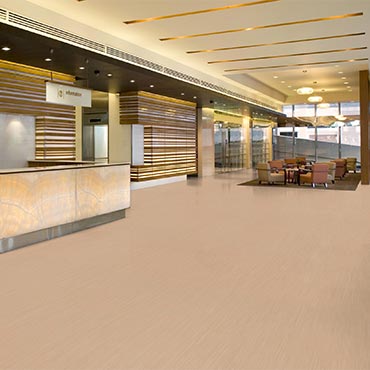One of the most natural and sustainable flooring solutions on the market, Tarkett linoleum has been appreciated for its natural beauty, comfort and durability for over 150 years. Our linoleum is made from 94% natural raw materials. Learn More
Linoleum Flooring
Linoleum Flooring Guide

Linoleum: An Eco-friendly and Durable Choice for Floor Coverings
Introduction:
Linoleum, a flooring material with a history dating back to the mid-19th century, has withstood the test of time. Once nearly forgotten in the wake of synthetic materials, it has seen a resurgence in recent years due to its eco-friendly properties and durable nature. Today, it is increasingly sought after as a viable and sustainable alternative to traditional flooring materials such as vinyl.
Composition and Manufacturing:
Linoleum is a natural product made from a unique blend of renewable materials. These include linseed oil, which gives linoleum its name, cork dust, wood flour, tree resins, ground limestone, and pigments. This blend is applied to a jute or canvas backing, creating a versatile and robust flooring material.
The manufacturing process for linoleum is relatively low-impact, contributing to its environmentally friendly reputation. The linseed oil, derived from flax seeds, oxidizes and forms a tough, rubber-like substance when combined with the other materials, a process known as "linoleum cement." This substance is then rolled onto a backing material and left to cure, a process that can take several weeks.
Sustainability and Environmental Impact:
Linoleum shines when it comes to sustainability and environmental impact. All its components are naturally occurring, and most are rapidly renewable. It doesn't release volatile organic compounds (VOCs) or other toxic chemicals into the environment, unlike some synthetic flooring materials. When linoleum flooring reaches the end of its lifespan, it's biodegradable and can be composted or otherwise responsibly disposed of. Furthermore, linoleum production requires less energy than that of many other types of flooring, reducing its carbon footprint.
Durability and Maintenance:
In addition to its green credentials, linoleum is appreciated for its exceptional durability and ease of maintenance. With proper care, it can last for several decades, sometimes outlasting other popular flooring options like vinyl or laminate . Linoleum is naturally resistant to scratches, dents, and stains, and it also possesses anti-bacterial properties, making it a good choice for allergy sufferers.
To maintain a linoleum floor, regular sweeping or vacuuming is usually sufficient to remove dirt and debris. When a deeper clean is required, a damp mop with a mild detergent will do the trick. It's advisable to avoid excessive water and harsh cleaners as they can damage the floor's surface.
Design and Aesthetic Appeal:
Linoleum is available in a vast array of colors, patterns, and styles. It can be cut into tiles or planks, or it can be installed as a sheet. This versatility in design options means that it can mimic the look of other materials like stone or wood, or it can be used to create bold, unique, and vibrant patterns. This versatility combined with its comfort underfoot has seen it become a popular choice in spaces like kitchens, playrooms, and commercial areas.
Conclusion:
In an age where environmental impact is increasingly a deciding factor in choice, linoleum stands out as a flooring material. Its natural composition, sustainability, durability, and versatility make it an excellent choice for those seeking an eco-friendly floor covering. As consumers continue to seek out products that combine function, aesthetics, and sustainability, it's likely that linoleum will continue to gain popularity.
Disclaimer: The information provided in this article is for general informational purposes only. While we strive to ensure the accuracy and reliability of the information presented, we make no warranties, express or implied, about the completeness, accuracy, reliability, suitability, or availability with respect to the content. Any reliance you place on such information is strictly at your own risk. We recommend consulting with professionals for specific advice tailored to your project’s needs, particularly regarding building codes, regulations, and product specifications.
Under no circumstances shall we be liable for any loss or damage, including without limitation, indirect or consequential loss or damage, arising from the use of, or reliance on, the information provided in this article.
Featured Brands
The Best 2 Linoleum Flooring Brands

Tarkett Linoleum Flooring
Profile | Website | Design Tools | Warranty | GreenOne of the most natural and sustainable flooring solutions on the market, Tarkett linoleum has been appreciated for its natural beauty, comfort and durability for over 150 years. Our linoleum is made from 94% natural raw materials. Learn More

Johnsonite Linoleum Flooring
Profile | Website | Install | Maintain | GreenHarmonium xf2™ Linoleum flooring is made up of five unique collections: Etrusco, Veneto, Veneto Acoustiflor, Lenza and Tonali. It's truly sustainable, beautiful and maintainable. Harmonium xf2 is made from 95 percent natural materials Learn More
Linoleum Flooring News
Latest Linoleum Flooring News
Marmoleum Solid Sheet...coa where we've added cocoa shells creating a unique granular look. Or take a look at the embossed Slate design that combines the aesthetics of stone with the warmth & purity of Marmoleum vintage linoleum flooring. Our renewed Marmoleum Solid collection presents 5 individual floor textures that provide the foundation for creating pure distinctive modern spaces. This innovative sheet l... |
Ultimate Guide to Vinyl Sheet Flooring...As with any type of flooring, vinyl sheet requires the occasional cleaning but overall it’s very easy to clean & maintain. Extremely durable. Vinyl sheet is often compared to linoleum flooring, but it is stronger and longer-lasting. It doesn’t scratch or stain easily, which makes it kid and pet-friendly. Ample variety. If you’re looking for floorin... |
What's the difference between linoleum and vinyl flooring?...Take a closer look at the similarities and differences of two resilient floors. Linoleum flooring and vinyl flooring often get mistaken for each other by homeowners who are searching for vinyl linoleum flooring that will look good for the long haul. Both floor types are indeed tough and long-lasting, and can be installed pretty much anywhere. But there are some important differences... |
Linoleum Flooring...Linoleum Flooring: A Timeless Choice for Modern Design Introduction:Linoleum flooring, often overshadowed by its contemporary counterparts, is making a remarkable comeback in the world of interior design. Known for its eco-friendliness and durability, linoleum is a versatile flooring option that offers both aesthetic appeal and practical benefits. Def... |

